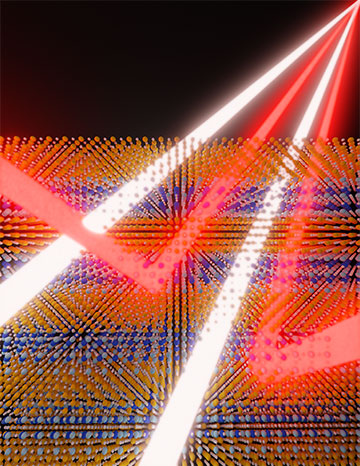
An artist’s rendering shows the material reflecting infrared light while letting other wavelengths pass through. [Image: A. Lenert, University of Michigan]
Nanophotonic structures could play important roles in electricity production and thermal conversion, if only they didn’t break down under the combination of high temperature and oxygen.
Now, researchers at two US universities have devised a nanophotonic heterostructure that remains stable in air up to 1100 °C (Nat. Nanotechnol., doi: 10.1038/s41565-022-01205-1). The material, made of alternating layers of two refractory minerals that do not melt and mix together at high temperatures, uses destructive interference to reflect infrared radiation while transmitting shorter-wavelength light. Computational modeling suggests that additional pairs of cubic-structured oxides could work in similar layered photonic structures.
Previous choices
Before the recent work, engineers working on selective thermal emitters had to choose between high-temperature, air-stable materials such as eutectic ceramics and ytterbium(III) oxide foams, which have limited spectral control, and existing nanophotonic materials such as plasmonic resonators and photonic crystals, which offer spectral tunability but fail at high air temperatures as material interfaces blur and crystalline structures fall apart.
The team, led by University of Michigan engineering professors Andrej Lenert and John T. Heron, first developed conceptual rules to predict how one-dimensional photonic crystals might resist degradation in high-temperature oxidizing environments. Graduate student team members from Michigan and the University of Virginia searched the Materials Project, an open-source database, for suitable candidates for a proof-of-concept experiment.
A stable structure
The group chose two materials: a perovskite with the chemical formula BaZr0.5Hf0.5O3 (BZHO) and magnesium oxide in its cubic crystal form. The researchers grew alternating layers of these two materials to form photonic crystals of varying thicknesses. After these photonic crystals were exposed to extreme heat in air, microscopic imaging showed no signs of intermixing of the two minerals, and the columns of atoms from layer to layer remained constant.
To test the design, the researchers used the heterostructures to filter thermal emission given off by two thermophotovoltaic materials heated as high as 1770 °C. The heterostructures acted as an efficient spectral filter.
The team’s search algorithms predict that other types of immiscible refractory crystals might lend themselves to similar nanophotonic designs with performance criteria tailored to more specific applications, such as thermophotovoltaic devices and solar energy conversion.
